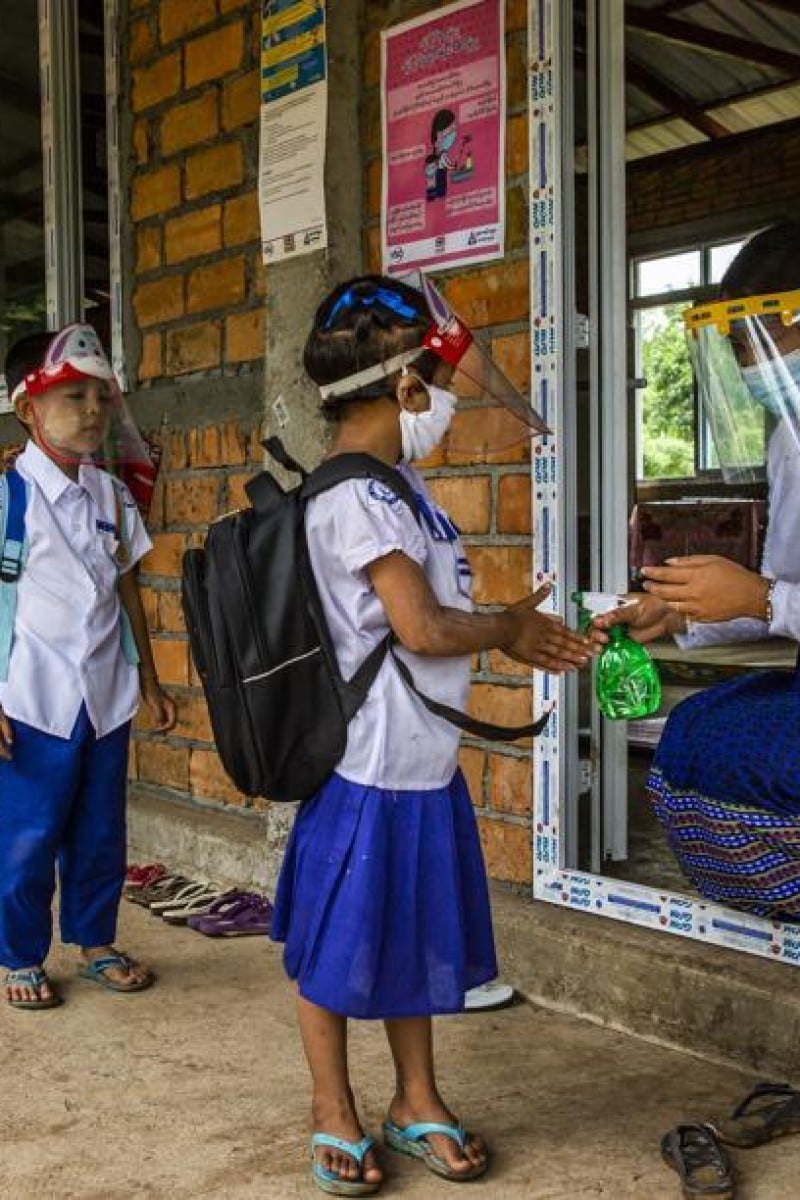
- Shut off due to military dictatorship until a few years ago, the country lacks the technology and supplies like face masks that allow children to attend class during the coronavirus pandemic
- Many students, especially those in rural areas like Mon State, have been forced to drop out, as they were unable to study during lockdown
 Students go back to school at Wei Paung village, Mon state on 20 August, 2020. Photo: VSO/ Nyan Zay Htet
Students go back to school at Wei Paung village, Mon state on 20 August, 2020. Photo: VSO/ Nyan Zay Htet
Schools across the world are reopening with coronavirus safety measures, equipment and social distancing in place, but not all students can afford face masks and basic back-to-school necessities. Myanmar is one such place. Shut off from the outside world due to military dictatorship until a few years ago, the country has not been spared from Covid-19.
It went into lockdown in May, with citizens advised to stay home and wear face masks when going out. Restrictions on movement have been put in place. However, research suggests that 50 per cent of schools nationwide and more than 50 per cent of health facilities are severely lacking in water, sanitation and hygiene services. This attracted the attention of Voluntary Service Overseas (VSO) during the onset of the coronavirus.
5 teens driving the important conversations
Students in rural areas, including Mon State, were particularly affected.
Located on the coast of south-eastern Myanmar, Mon State comprises numerous small islands and accounts for nearly half of Myanmar’s rubber production. Agriculture and fisheries also play a big role in its economy.
According to a 2012 report published by Unicef and the Myanmar Information Management Unit, only 13 per cent of children aged between three and five attended preschool in Mon State. Nearly 12 per cent of children had no access to primary education.
Students wash their hands at Mon National Post Primary School at Wei Paung village. Photo: VSO/ Nyan Zay Htet
Among those who do attend classes, a little more than half complete their schooling within the expected five years. And in July, as classrooms finally began to reopen, the country was hit with a second wave of the pandemic.
The situation in Mon State was so bad the VSO had to act quickly to ensure the students’ education did not come to a complete standstill once restrictions were eased. The not-for-profit charity worked closely with the Mon National Education Committee to distribute back-to-school kits containing milk, soap and face visors for 10,000 children, and food supplies for more than 700 teachers to help them cope with the crisis. In addition, 27 teachers received digital literacy training for online teaching.
Hong Kong secondary students help children identify learning disabilities
And the results have been encouraging. Mi Kya Maw Non, a student at Wei Paung Post-Primary School, would have dropped out of school if not for the initiative. “I got soap, masks, milk and some stationery from the school. These have helped me to prevent [catching] the virus … In the past, when I had nothing to protect me, I was frightened of getting infected,” the nine-year-old says. “My mother wanted me to drop out of school this year, but with the help from the school, she changed her mind.”
Others like Min Aung Myint Myat, 15, explained that he had to help out at his family’s farm and did not have much opportunity to study during the lockdown. The Wei Paung Post-Primary School student was only able to continue his studies thanks to the supplies provided.
Min worked on his family's farm growing betel and lemon seeds when Covid-19 struck Mon state. Photo: VSO/ Nyan Zay Htet
For teachers, going back to school was no easy feat either. Mi Ar Jae Noor, an assistant teacher at Wei Paung School, says: “There are too many students and we have only 30 seats, so children cannot attend school as normal. According to Covid-19 prevention procedures, the seats have to be six feet apart. With this regulation in place, we’ve split classes into two segments: one in the morning, another in the evening.”
Students at HKUST develop 3D artificial eye inspired by science fiction
Since school reopened in July, she adds, all the students have returned, and enrolment has also increased. “This is crucial because if the school were to close for a long time because of lockdown, the students from Grades Six and Seven would be out of school because they are becoming adolescents,” she says.
Students learn in their classroom at Mon National Post Primary School, Wei Paung village. Photo: VSO/ Nyan Zay Htet
“Once children have dropped out, it becomes very difficult to bring them back.”
Sadly, this might become the reality for many students like Yin Moe Khaing, because all schools in Myanmar have closed since August 27 with a new spike in Covid-19 cases. Yin is currently stuck at home and is uncertain when she can resume classes. The 13-year-old hopes to become a doctor so she can take care of her elder brother who has been disabled since birth.
Yin hopes to go back to school soon and pursue her dreams. Photo: VSO/ Nyan Zay Htet
“I went to Wei Paung Primary School [in Wei Paung village], but I am a Grade Eight student now and our school does not have classes for this grade,” she says. “So, I have to shift to a high school in another town … The school announced that it would reopen in October, hopefully then I can study and see my friends again. Otherwise, my whole life will just be performing domestic chores.”
